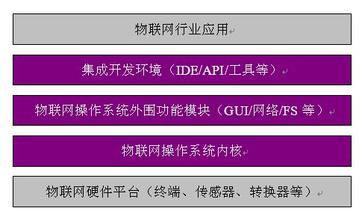The architecture and basic functions of the IoT operating system
The Internet of Things operating system consists of a kernel, auxiliary peripheral modules (file system, graphical user interface, communication protocol stack, drivers for various common devices, etc.), integrated development environment, etc. Based on this, a series of industry-specific Application, the following figure shows the concept:

The Internet of Things operating system is different from traditional personal computer operating systems and smartphone-based operating systems. It has some unique features in the field of Internet of Things applications.
The characteristics of the Internet of Things operating system kernel
1. The kernel size is flexible and can adapt to different hardware platforms. For example, in an extreme case, the kernel size must be kept within 10K to support sensors with limited memory and CPU performance. At this time, the kernel has basic task scheduling and communication functions. In the other extreme case, the kernel must have complete functions such as thread scheduling, memory management, local storage, complex network protocols, and graphical user interfaces to meet the requirements of highly configured smart IoT terminals. At this time, the size of the kernel will inevitably increase greatly, and it can reach several hundred K or even M. This scalability of kernel size can be achieved through two levels of measures: recompilation and binary module selection loading. The recompilation measure is very simple. You only need to select the required function modules according to different application goals, and then recompile the kernel. This measure is used when the kernel customization is very deep, such as when the size of the kernel is required to be less than 10K. The binary module chooses to load, which is used in the case of kernel customization is not very deep. At this point, maintain an operating system configuration file that lists all the binary modules that the operating system needs to load. After the kernel initialization is complete, the required binary modules are loaded according to the configuration file. This requires the terminal device to have external storage (such as hard disk, Flash, etc.) to store the binary module to be loaded;
2. The real-time nature of the kernel must be strong enough to meet the needs of critical applications. Most IoT devices require the operating system kernel to be real-time, because many key actions must be completed in a limited amount of time, otherwise it will lose its meaning. The real-time nature of the kernel implies many levels of meaning. The first is the real-time nature of the interrupt response. Once an external interrupt occurs, the operating system must respond to the interrupt and process it in a short enough time. Second is the real-time nature of thread or task scheduling. Once the resources required by the task or thread or the conditions for further operation are ready, they must be able to be dispatched immediately. Obviously, kernels based on non-preemptive scheduling are difficult to meet these real-time requirements;
3, the kernel architecture is scalable. The kernel of the IoT operating system should be designed as a framework that defines interfaces and specifications. As long as these interfaces and specifications are followed, new hardware support for new functions can be easily added to the operating system kernel. Because the application environment of the Internet of Things has a broad spectrum of features, the operating system must be able to scale to adapt to the new application environment. The kernel should have a device management mechanism based on bus or tree structure that can dynamically load device drivers or other core modules. At the same time, the kernel should have dynamic loading of external binary modules or applications. These applications are stored on external media, so there is no need to modify the kernel. Only new applications need to be developed to meet specific industry needs.
4. The kernel should be safe and reliable enough. Needless to say, the IoT application environment is characterized by high automation and low human intervention, which requires the kernel to be reliable enough to support long-term independent operation. Security is even more critical for the Internet of Things, even related to the country's lifeline. For example, an insecure kernel is applied to the national grid control, and once it is invaded by the outside, the impact will be incalculable. To enhance security, the kernel should support mechanisms such as memory protection (such as VMM) and exception management to isolate the wrong code if necessary. Another security strategy is not to open source code, or to open key parts of the kernel source code. Undisclosed source code is just a security policy and does not mean that the kernel cannot be applied free of charge;
5, energy saving, to support enough power life. The operating system kernel should reduce the CPU operating frequency when the CPU is idle, or simply shut down the CPU. For peripheral devices, the operating status should also be judged in real time, and once it enters the idle state, it switches to the power saving mode. At the same time, the operating system kernel should minimize the frequency of interrupts, such as adjusting the clock frequency of the system to the lowest possible, without affecting real-time performance, to maximize power savings.
steel Signal Pole, Traffic Signal Pole, steel Sign Post, Monitor Pole
YIXING FUTAO METAL STRUCTURAL UNIT CO.,LTD( YIXING HONGSHENGYUAN ELECTRIC POWER FACILITIES CO.,LTD.) , https://www.chinasteelpole.com